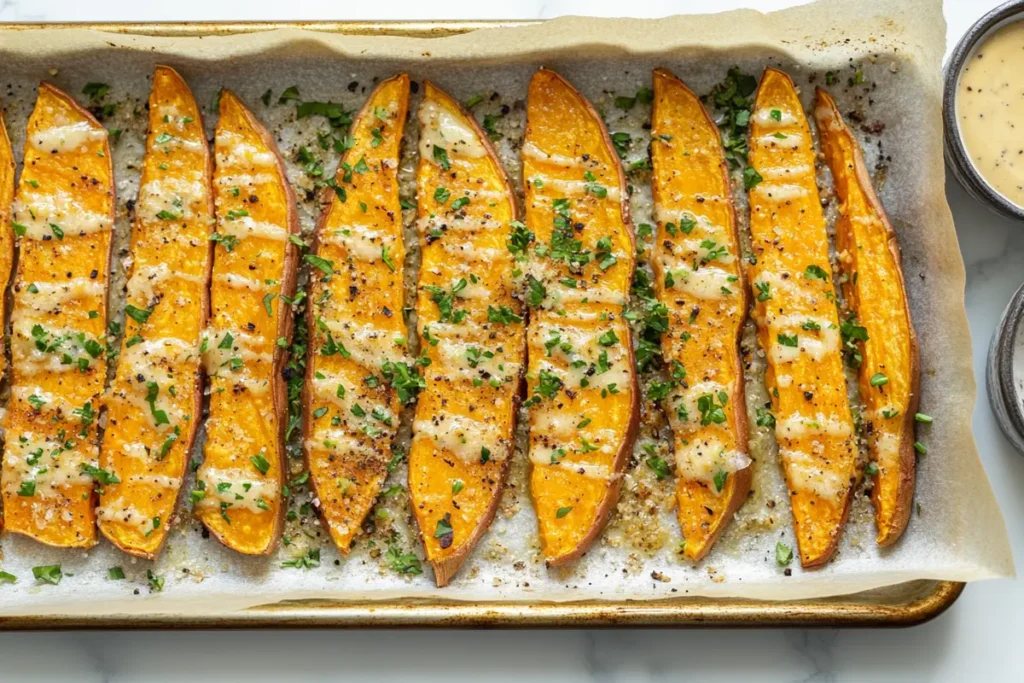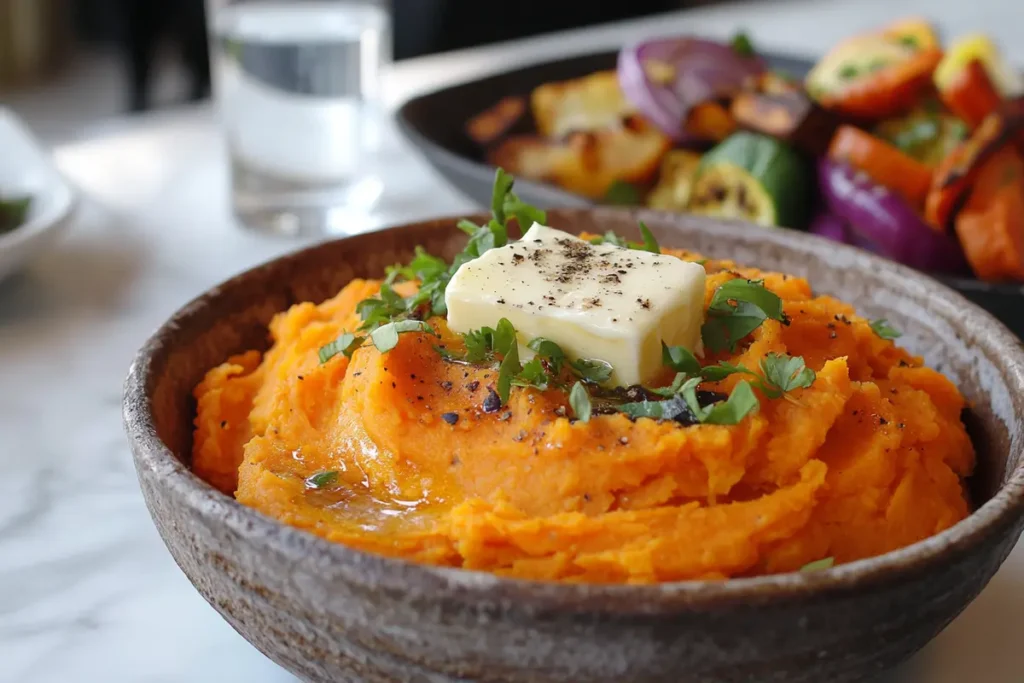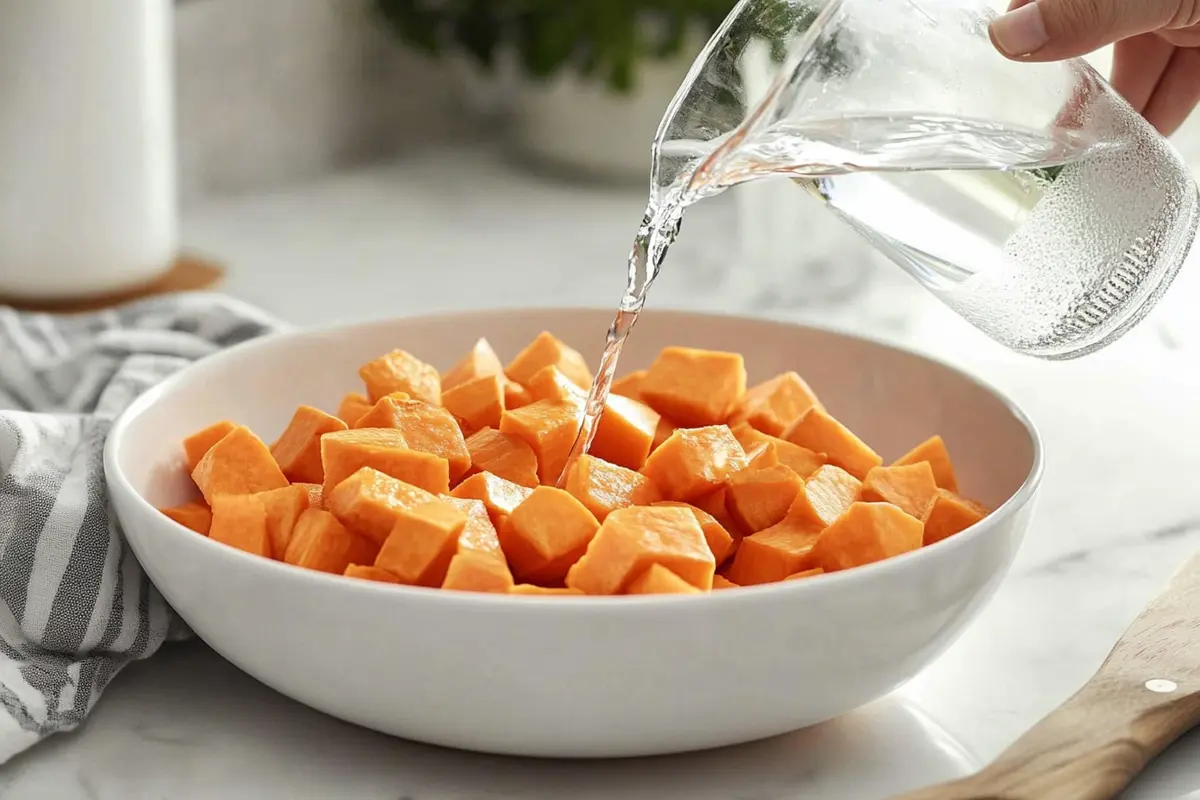Sweet potatoes are a favorite in many kitchens, thanks to their versatility and rich, natural flavor. But have you ever wondered, why do you soak sweet potatoes before baking? This simple step offers surprising benefits, from improving texture to saving precious baking time. Soaking sweet potatoes isn’t just for the pros—it’s a game-changer for anyone looking to create perfectly tender and flavorful dishes. In this article, we’ll dive into the science behind soaking, explore its advantages, and share tips to help you make the most of this practice. Whether you’re a seasoned chef or just getting started, understanding why you soak sweet potatoes before baking might transform your cooking routine.
The Science Behind Soaking Sweet Potatoes
What Happens When Sweet Potatoes Are Soaked?
Soaking sweet potatoes isn’t just a fancy step; it has a solid scientific basis. Sweet potatoes are rich in starch, which can cling to their surface and impact the way they cook. When you soak them, water washes away some of this surface starch, leading to a smoother texture and preventing that sometimes powdery coating. Starch content plays a significant role in the outcome of baked sweet potatoes, making this step a helpful trick.
Additionally, soaking sweet potatoes reduces oxidation. When exposed to air, the flesh can quickly turn brown due to polyphenols like chlorogenic acid. Soaking creates a water barrier, keeping the sweet potatoes fresher-looking and more vibrant as they bake.
Breaking Down Starch and Polyphenols
Let’s talk numbers. A typical sweet potato contains about 12.7 grams of starch per 100 grams. By soaking them for just 30–60 minutes, you can rinse off some of this excess starch. This simple step not only improves the texture but also ensures even baking.
Polyphenols, like caffeic and chlorogenic acids, are responsible for oxidation and browning. When these compounds react with air, they darken the surface of the sweet potato. Soaking interrupts this process, so you get beautifully baked sweet potatoes with a consistent golden hue.
Benefits of Soaking Sweet Potatoes Before Baking
Better Texture and Flavor

Soaking sweet potatoes removes excess starch from their surface. This helps them cook evenly and prevents that dry or powdery texture that sometimes appears. If you’ve ever wondered why do you soak sweet potatoes before baking, this is a key reason.
The process also lets the sweet potatoes absorb a bit of moisture, which softens the interior. Whether you’re making fries, chips, or simple roasted pieces, soaking ensures a tender, enjoyable texture that’s easy to achieve.
Time-Saving Benefits
Soaking isn’t just about texture—it also reduces baking time. Sweet potatoes that have been soaked typically bake 10–15 minutes faster than unsoaked ones. This happens because the water starts breaking down the fibers, so they require less time in the oven to become tender.
For comparison, unsoaked sweet potatoes typically bake for around 60 minutes, whereas soaked sweet potatoes are ready in as little as 45–50 minutes. That’s a significant time saver when you’re in a rush to get dinner on the table!
By starting with soaked sweet potatoes, you’ll also find that the baking is more consistent. You won’t end up with some pieces being undercooked while others are too soft—perfect for recipes like baked sweet potato fries or casseroles.
Reduced Browning and Oxidation
No one likes to see their beautifully peeled sweet potatoes turning brown before they even hit the oven. This discoloration is caused by oxidation, a natural reaction between air and the sweet potato’s polyphenols. Soaking interrupts this reaction, keeping the flesh vibrant and fresh.
For the best results, immerse your sweet potatoes in cold water as soon as they’re peeled. Not only does this prevent browning, but it also creates a smoother surface for baking. This simple step ensures that your finished dish looks just as good as it tastes.
Flavor Enhancements Through Soaking
Infusing Sweet Potatoes with Flavors
Did you know that soaking sweet potatoes can also enhance their flavor? It’s true! While plain water works just fine, using flavored liquids opens up endless possibilities. For instance, soaking sweet potatoes in apple juice or cinnamon-infused water adds a touch of natural sweetness and warmth. Other options like broth or wine can give a savory twist to your dish, perfect for hearty sides.
The porous nature of sweet potatoes allows them to absorb subtle flavors during soaking. This means you can customize your sweet potatoes to suit any meal. A quick soak in spiced water with ginger or nutmeg can elevate their taste for holiday dinners or special occasions.
Top Soaking Recipes for Added Taste
For those who want to try soaking with a twist, here are a few ideas to get started:
- Cinnamon Water Soak: Combine cinnamon sticks and a dash of nutmeg in warm water. Let it cool before soaking your sweet potatoes for 30 minutes.
- Savory Herb Soak: Use vegetable broth infused with rosemary and thyme to give your sweet potatoes a delicious herbal flavor.
- Citrus Soak: Add orange or lemon juice to the water for a zesty kick.
These simple techniques can turn plain baked sweet potatoes into a flavorful masterpiece. For more creative recipes, visit Together Recipes, where you’ll find unique ways to transform everyday ingredients.
How to Soak Sweet Potatoes Correctly
Step-by-Step Guide
If you’ve ever asked yourself, why do you soak sweet potatoes before baking? mastering this simple technique is a great place to start. Soaking sweet potatoes not only removes excess starch but also ensures they bake evenly and develop the perfect texture.
Follow these steps to get it right:
- Peel and Slice: Begin by peeling and slicing the sweet potatoes into your desired shape—whether that’s cubes, wedges, or slices.
- Soak in Cold Water: Place the sweet potatoes in a large bowl of cold water. Let them soak for 30–60 minutes. This allows enough starch to be washed away while keeping the sweet potatoes firm enough for baking.
- Drain and Dry: After soaking, pour off the water and use a clean kitchen towel to pat the sweet potatoes dry. Drying them thoroughly prevents moisture from causing them to steam in the oven, which could lead to a soggy texture.
These steps are quick and easy but make a noticeable difference in your baked sweet potatoes. Whether you’re making fries, chips, or a classic baked dish, soaking gives you a leg up on achieving restaurant-quality results.
What You’ll Need
Here’s a quick checklist of essentials for soaking sweet potatoes:
- Fresh Sweet Potatoes: Pick firm, unblemished ones for the best results.
- Cold Water: Helps remove starch and prevent browning.
- Clean Kitchen Towel: Crucial for drying sweet potatoes thoroughly before baking.
Understanding why do you soak sweet potatoes before baking not only answers a common cooking question but also equips you to make this easy preparation step a regular part of your routine.
Want to learn more about perfect preparation techniques for baking vegetables? For more ideas and guidance, check out the recipes on Together Recipes.
Drying Techniques Before Baking
Once you’ve soaked the sweet potatoes, it’s crucial to dry them thoroughly. Excess water left on the surface can lead to soggy baked potatoes, which no one wants. Use a clean kitchen towel or paper towels to pat them dry. For best results, let them air-dry for a few minutes before seasoning or baking.
Drying sweet potatoes properly is particularly important when making baked sweet potato fries or chips, as it helps them achieve that much-desired crispy texture. If you skip this step, you risk steaming your sweet potatoes instead of baking them, which might result in an uneven texture.
Final Tips
Recap of Soaking Benefits
Soaking sweet potatoes before baking is a simple yet powerful step that can elevate your cooking. It removes excess starch, softens the texture, reduces oxidation, and even allows for creative flavor infusions. On top of all that, it can save you precious baking time—what’s not to love? Whether you’re preparing a holiday feast or just cooking for a weeknight dinner, this trick can make your sweet potatoes the star of the meal.
Final Tips for Perfectly Baked Sweet Potatoes
Here are some quick tips to ensure your sweet potatoes turn out perfectly every time:
- Don’t skip the drying step: Thoroughly drying soaked sweet potatoes helps avoid sogginess.
- Experiment with flavors: Try soaking in cinnamon water, broth, or fruit juice for added taste.
- Cut evenly: For even baking, slice your sweet potatoes into uniform pieces.
- Use the right temperature: Bake at 400°F for a perfect balance of crispy edges and soft interiors.
For more delicious recipes and preparation tips, browse the recipe collection on Together Recipes. You’ll find everything from side dishes to main courses to inspire your next meal.
The Takeaway: A Simple Step for Better Results
Soaking sweet potatoes is a straightforward step that doesn’t take much time but yields impressive results. Whether you’re baking for a family dinner or prepping for a holiday feast, this little trick can make all the difference. The next time you’re peeling and chopping sweet potatoes, don’t forget to give them a soak—you’ll be glad you did!
For more tips and tricks, check out Together Recipes, where you’ll find plenty of ideas to enhance your cooking skills.
Common Mistakes When Soaking Sweet Potatoes
Over-Soaking the Sweet Potatoes
While soaking sweet potatoes before baking is beneficial, over-soaking them can lead to soggy, overly soft results. Sweet potatoes left in water for too long—particularly over several hours—may lose some of their natural flavors and nutrients. This is because water-soluble vitamins like vitamin C can leach out during prolonged soaking. To avoid this, stick to the recommended soaking time of 30–60 minutes. If you need to soak them for a longer period, refrigerate them and ensure they are fully submerged to prevent oxidation.
Not Drying Them Properly
After soaking sweet potatoes, one of the most important steps is drying them thoroughly before baking. Any leftover moisture can create steam in the oven, leading to less crispy and unevenly baked potatoes. To get the best results, pat them dry with a clean towel and let them air dry for a few minutes. This small step ensures your sweet potatoes bake perfectly, whether you’re making fries, chips, or a simple baked dish.
Expert Tips for Perfectly Baked Sweet Potatoes Every Time
Experiment with Soaking Liquids
One way to elevate your sweet potatoes is to experiment with flavored soaking liquids. Instead of plain water, consider using options like apple juice, spiced water, or herbal broths. These liquids infuse subtle but noticeable flavors into the sweet potatoes, enhancing the overall dish. For example, soaking in orange juice adds a citrusy tang, while cinnamon-infused water provides a warm, sweet aroma. This is an excellent way to customize your sweet potatoes for holidays or special occasions.
Pairing Soaked Sweet Potatoes with Recipes

After soaking, sweet potatoes can shine in a variety of recipes. From crispy baked fries to creamy casseroles, the soaking process ensures a better texture and enhanced flavor. For an easy recipe idea, consider pairing your soaked sweet potatoes with honey-glazed toppings or a sprinkle of paprika for a savory twist. If you’re looking for more inspiration, visit Together Recipes for a range of creative dishes that perfectly complement soaked sweet potatoes.
FAQs: Addressing Common Concerns
What Happens If You Don’t Soak Potatoes?
Skipping the soaking step may lead to a firmer, less tender texture in your baked sweet potatoes. The surface may also feel slightly powdery due to the remaining starch. Additionally, unsoaked sweet potatoes are more prone to uneven baking and may brown faster because of oxidation. While soaking isn’t mandatory, it’s a small effort that significantly improves the final results.
Why Are My Sweet Potatoes Still Hard After Baking?
Hard sweet potatoes after baking can be frustrating, but it often comes down to undercooking or uneven cooking. Soaking sweet potatoes before baking helps soften the interior fibers, making it easier for them to cook evenly. Be sure to cut your sweet potatoes into similar-sized pieces for consistent baking. If the problem persists, try increasing the baking time slightly or soaking for a bit longer to give the fibers more time to break down.
Why Won’t My Sweet Potato Chips Get Crispy?
Achieving crispy sweet potato chips can be tricky, but soaking is a game-changer. Removing starch from the surface allows the chips to crisp up properly in the oven. After soaking, make sure to dry them completely, as any leftover moisture can cause steaming instead of crisping. Toss the slices with a light coating of oil and bake them at a high temperature (around 425°F) for best results.
Is It Better to Bake Sweet Potatoes in Foil or Not?
Wrapping sweet potatoes in foil traps steam, resulting in softer, moister interiors. However, if you prefer crispy skin, it’s best to bake them without foil. For the best of both worlds, consider starting the baking process with foil and removing it halfway through. Whether you use foil or not, soaking sweet potatoes first will still enhance their texture and flavor.
A Final Word on Soaking Sweet Potatoes
Why Do You Soak Sweet Potatoes Before Baking?
Soaking sweet potatoes before baking removes excess starch, softens the texture, and prevents uneven cooking. This simple step also helps your sweet potatoes retain their vibrant color and achieve a tastier, more visually appealing finish. If you’re aiming for better baked dishes, soaking is definitely worth it!

